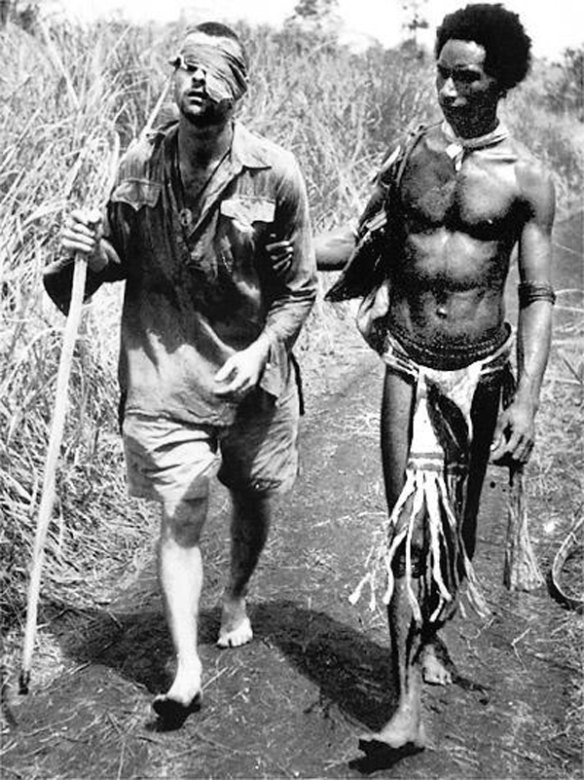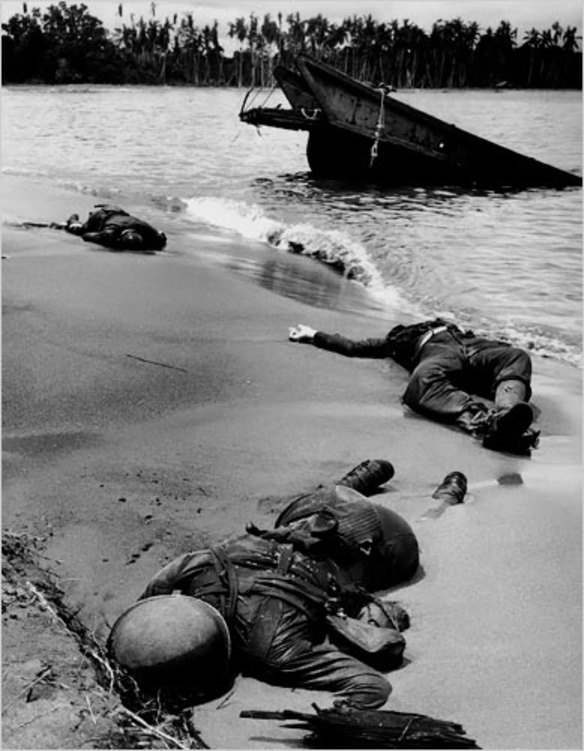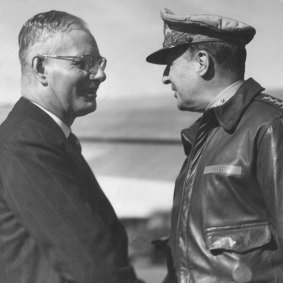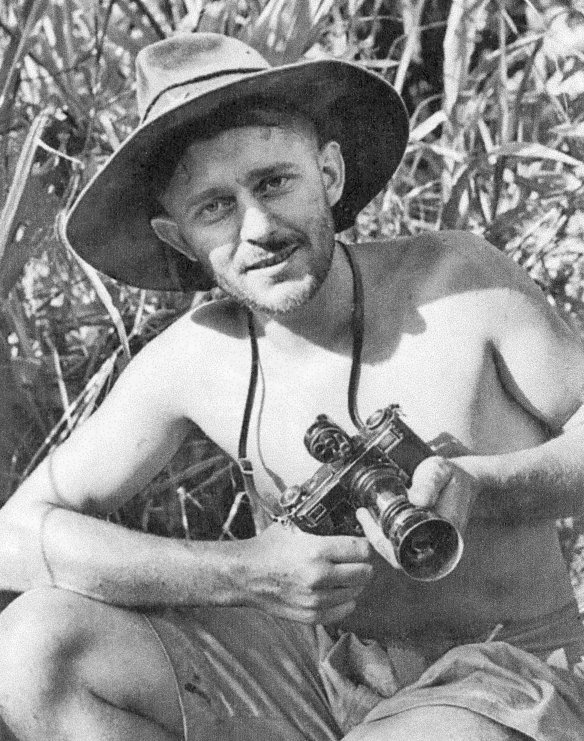By Tony Wright
The most famous Australian photograph of World War II in New Guinea might never have seen the light if prime minister John Curtin and his censors had managed to have their way.
The photo may never have even made it from the battlefield if a soldier had not used his boot to roll over the body of the collapsed photographer, believing him to be dead.
And the picture would have sat indefinitely, banned from publication, in the archives of Australia’s department of information if the photographer, 26-year-old George Silk, had not smuggled it to the editors of Life magazine in New York.
More than 80 years later, the image remains a treasure in the story of Australia.
It is The Blind Soldier.
It depicts a Papuan “Fuzzy Wuzzy Angel”, Raphael Oimbari, tenderly guiding an Australian soldier, Private George “Dick” Whittington, away from the deadly battle of Buna on the Papuan coast, his eyes covered with a rag.
It was Christmas Day, 1942.

Private George “Dick” Whittington is guided from the battle of Buna by “Fuzzy Wuzzy Angel” Raphael Oimbari, Christmas Day, 1942.Credit: George Silk
The astonishing story of Silk and his most famous photograph lie at the heart of a new book, The Buna Shots, by Australian historical author and novelist Stephen Dando-Collins.
Silk, however, is only half Dando-Collins’ story, researched and written with such virtuosity that it all but begs to be made into a movie.
The other is American combat photojournalist, George Strock, of Life magazine.
Seven days after Silk shot his photo near Buna, Strock took a photograph just a few kilometres up the beach that would captivate the American public.
It was such a desolate, confronting image that US censors refused to allow it to be published. Finally, after months of lobbying by Life, it took the personal blessing of no less than the US president, Franklin D. Roosevelt, before the American public was permitted to see it.
It became known simply as Three Dead Americans on Buna Beach.
When it was published in Life magazine in September 1943, it was the first time any photograph depicting dead American troops had appeared in any American publication during World War II.
Together, the two images – Silk’s The Blind Soldier and Strock’s Three Dead Americans on Buna Beach – are credited with firing the Australian and American public’s support for their hard-pressed troops to the point that the images changed the course of the war.
Time magazine in 2014 went so far as to describe Strock’s picture as “the photograph that won the war”.

Three Dead Americans: on Buna Beach: George Strock’s famous photo required the consent of US president Franklin D. Roosevelt before it could be published in 1943.Credit: George Strock
Silk’s photograph, having been published in America while banned in Australia, was subsequently “unbanned” and used by the Australian government to help raise tens of millions of pounds in Liberty bonds for the war effort.
It was cynical.
While the US president had stepped in to support the work of Strock, believing Americans should be strong enough to confront the reality of war, the Australian prime minister, Labor’s John Curtin, made sure Silk suffered.

PM John Curtin meets General MacArthur in 1943.Credit: Fairfax
The brilliant, daring young photojournalist was accused of treason and forced to resign as a war photographer from the Australian department of information.
Curtin, Dando-Collins makes clear in his book, was likely to have been in thrall at the time to the blowhard US General Douglas MacArthur, supreme Allied commander for the Southwest Pacific. MacArthur liked pictures of victories and, unlike his president, insisted public morale would be endangered by pictures of wounded soldiers.
Silk’s treatment by Curtin’s government was considered so appalling that his friend Damien Parer – still considered among Australia’s greatest combat cinematographers and the subject of Australia’s first Oscar-winning film (Kokoda Front Line, 1943) – resigned from the department of information in protest himself.
It is the detailed telling of the censoring and bloody-minded treatment of Silk by the Australian authorities that grants heft to the timeless quotation chosen for the dedication page of The Buna Shots: “The first casualty when war comes is truth” – Hiram W. Johnson, US senator, 1917.
And what was Silk’s crime in the eyes of officials of the Australian wartime propaganda machines and PM Curtin, a former journalist himself?
The crime was getting his photo published elsewhere. Frustrated because Australia’s censors would not release what he considered his best combat photos (including two Bren gunners assaulting a Japanese bunker at Giropa Point, Papua, shortly before they were killed) Silk had arranged for his work to be smuggled to Life magazine.
When The Blind Soldier ran across a full page in that magazine on March 8, 1943, it attracted truckloads of letters from admiring readers, including one from Dallas, Texas, declaring “Never has a more stirring yet pathetic picture been published by any magazine or newspaper”.
How Silk captured the image on Christmas Day, 1942, is one of many dozens of extraordinary vignettes that make Dando-Collins’ book such a captivating read.
Silk was staggering along a jungle trail alone, trying to catch up with Australian soldiers hurrying to reinforce their mates of the 2/10th Australian Infantry Battalion, who were caught up in fierce fighting against Japanese holed up in bunkers at Buna.
Silk and his cameras had already been in the thick of action in North Africa, Syria and Crete. He and fellow photographer Parer had begun to win legendary status by covering Australia’s besieged Rats of Tobruk in Libya in 1940, with Parer filming cinecamera footage and Silk concentrating on still shots.
Silk had been taken prisoner by German field marshal Erwin Rommel’s Afrika Corps, but escaped 10 days later with his cameras intact.
When he arrived in the punishing heat, humidity and sucking mud of New Guinea, he insisted on shooting pictures on the front lines of battle.
On the track to Buna, Silk saw two figures walking towards him.
Both were barefoot. The Australian soldier with the rag covering his eyes, “Dick” Whittington, had lost his boots when he was thrown through the air after Japanese shellfire had caused an Australian tank he was walking behind to explode. One of the many Papuan men employed as carriers for the Australian soldiers, Haita Heviki, dragged Whittington clear and bound his eyes.
The following day, a series of Papuans, forever known as “Fuzzy Wuzzy Angels”, took turns leading Whittington from Buna across country for medical help while others carried wounded soldiers on stretchers.
Silk took just one photo of Whittington and Raphael Oimbari before weaving off to the battle.
(Whittington regained his sight, only to die within two months of scrub typhus.)
Silk spent the rest of the day photographing the battle at Buna between Australian and Japanese fighters.
He dodged bullets, but he couldn’t dodge an attack of malaria.
He collapsed face down. Towards sunset, an Australian soldier found him among the bodies of dead soldiers. Trying to identify them, the soldier rolled Silk over with his boot. Silk groaned. He was evacuated by stretcher bearers and flown to hospital in Port Moresby.
And so began the long and tortuous tale of the photograph of The Blind Soldier.
By the time the picture was gaining fame and its creator had been forced to resign from Australia’s employ because of it, a new theatre of war awaited George Silk.

George Silk in the field near Buna, New Guinea, in 1942.
Life – at the time the world’s greatest pictorial magazine – took him on and sent him to cover the closing chapters of World War II in Europe. He photographed US troops entering Rome and was one of two photojournalists assigned by Life to cover the D-Day landings in Normandy. The other, the legendary Robert Capa, went ashore with the troops, but produced only blurred pictures which Life attributed to his shaking hands.
Silk flew aboard a glider, which crash-landed behind Utah beach. Fourteen of the glider’s occupants died in the crash or of their injuries later. Silk was the only survivor, and he photographed the dead soldiers beside the smashed glider, taking care to place groundsheets over their faces.
He was wounded by a German grenade after crossing the Roer River in Belgium, soldiers dying around him. He still managed to have 16 photographs of that deadly day published in Life.
Later, sent to Japan after it surrendered, he hitched a ride on a military plane and took the first pictures of Nagasaki, the second city in Japan to be destroyed by an atomic bomb.
Silk took American citizenship in 1947 and won fame and wealth photographing celebrities and his great love, sporting events.
He died in Connecticut in 1988.
Australia never gave him an award or honour.
This year, belatedly, he was featured in a retrospective at the National Portrait Gallery, and Australia Post issued a commemorative stamp series featuring Silk, Parer and First World War photographer Herbert Baldwin.
The series’ first day cover featured The Blind Soldier.
Raphael Oimbari eventually became a national hero in Papua New Guinea. He was made an Officer of the Order of the British Empire (OBE), and remains the official figurehead of the Fuzzy Wuzzy Angels. The Australian high commissioner to PNG attended his funeral in 1996.
The Buna Shots, by Stephen Dando-Collins, Australian Scholarly Publications.